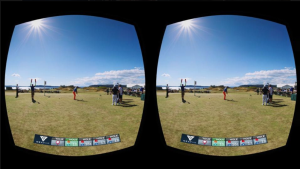Watching sports in virtual reality: Q&A with NextVR chairman after startup inks deal with FOX
 In what NextVR Chairman Brad Allen calls a “milestone for the industry,” FOX Sports inked a 5-year deal with the Laguna Beach, Calif.-based startup earlier this month to stream virtual content from its live sports broadcasts.
In what NextVR Chairman Brad Allen calls a “milestone for the industry,” FOX Sports inked a 5-year deal with the Laguna Beach, Calif.-based startup earlier this month to stream virtual content from its live sports broadcasts.
The partnership is another reminder of the fast-growing virtual reality industry and shows that traditional media giants like FOX are taking VR seriously. Given how fast the technology is improving and how hardware is becoming cheaper and easier to access — see Samsung’s most recent bundle deal — watching live sporting events in virtual reality could become a regular experience for fans faster than most people expect.
“It’s been a really fun partnership because we are both sitting on the same side of the table and helping to build the VR market together,” Allen told GeekWire about the deal with FOX. “That’s a big point.”
GeekWire: From a hardware and software perspective, this seems difficult. What does this production look like on the tech side?
Allen: “First off, from the camera side of things, we’re able to do this now because of the way we were compressing data for 3D TV back in 2009. That’s basically our secret sauce: the ability to compress all of the data. The cameras capture 24,000 pixels horizontally and 6,000 pixels vertically — that is a lot to send through to a mobile device. We compress it aggressively and we’re also able to send it through at 4-to-8 megabytes per second, with 60 frames per second. That’s about the same as a live HD stream from Netflix and really is what allows us to do what we do in real-time and also dynamically add in all these different elements during an event.
Pages
- About Philip Lelyveld
- Mark and Addie Lelyveld Biographies
- Presentations and articles
- Tufts Alumni Bio